The Role of Farmer Input in the Design of Assistive Technologies: A Focus on Agricultural Exoskeletons
ID
ALCE-304NP
Introduction
AgrAbility is a state-wide program that brings together Virginia Tech, Virginia State University, Virginia Cooperative Extension, and Easterseals UCP to meet its goal of promoting safety, wellness, and accessibility on the farm. The collaborative nature of AgrAbility Virginia provides unique opportunities to find creative solutions to support farmers, farmworkers, and farm families. Since 2018, AgrAbility Virginia has been working with Virginia Tech engineers through a National Science Foundation (NSF) funded project to explore the possibility of flexible exoskeletons as an appropriate assistive technology new to agriculture.
Assistive technology is any technology, simple or complex, that helps an individual carry out an activity or task. This can include anything, ranging from additional steps added to a tractor, hand- controls to replace foot pedals, adapted user- interfaces, to exoskeletons (Grisso et al. 2010; Ehlers and Field 2019). Exoskeletons are high-tech wearable devices designed to provide additional strength or support to the user (Upasani et al. 2019, 2). Assistive technology does not need to be high tech to be of use, however, complex tasks like mimicking the human body do call for more advanced solutions (Grisso et al. 2010; Sarac, Solazzi, and Frisoli 2019, 2).
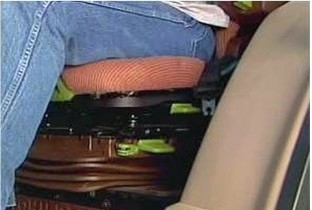
The AgrAbility Virginia team sees potential for agricultural exoskeletons to improve accessibility and mitigate injury on the farm. Exoskeletons come in a variety of types and configurations. Whether the need is for hand, knee, back, or full-body support, there is an exoskeleton designed to help (Sarac, Solazzi, and Frisoli 2019; Toxiri et al. 2019). However, at present, exoskeletons are primarily used for military, commercial, and medical purposes (Sarac, Solazzi, and Frisoli 2019). Expanding their use more widely into agriculture could provide a tangible increase in the health and safety of farmers and farmworkers, while meeting the unique work requirements of the agricultural industry.
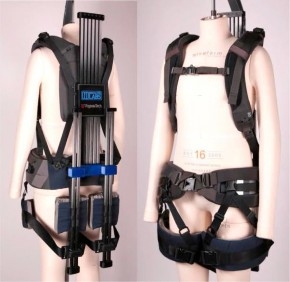
Agricultural Industry
Our society relies on the health and wellbeing of farmers for our most basic needs. While providing food and resources, workers in the agricultural industry must confront a slew of workplace conditions and health and safety concerns. Unlike many American workers, farmers and farmworkers do not have a consistent and predicable work schedule. The work they do day-to-day changes with the crops/livestock, the season, and the weather. Adapting to those factors is key in maintaining a strong and able agricultural workforce. One way we can help in that effort is to provide adequate assistive technology. Agricultural-specific exoskeletons can be designed with input from the farmers and farmworkers themselves to ensure that this assistive technology is applicable to their unique work environment.
Health and Safety
Agricultural health and safety have been at the forefront of AgrAbility’s priorities since the program began. Agriculture is integral to the American economy and for many farmers, agriculture is not just a profession, it’s a way of life. With more advanced machinery, farmers working longer into life, and occupational strains on the body, exoskeletons can provide relief and rehabilitation.
Common Injuries
Agriculture is considered to be one of the most hazardous professions in the world (Johnson et al. 2021). Farmers, ranchers, and farmworkers routinely report suffering injuries on the job at a rate much higher than other industries. While the nature and severity of injuries varies, musculoskeletal injuries of the lower-back remain common across all agricultural enterprises (Upasani et al. 2019).
Secondary injuries are also a major concern in agricultural work. Unlike some industries, the work on the farm does not stop while the farmer recuperates. As such, farmers often continue to work through an injury, which may lead to improper healing and increases the risk of additional injury (Johnson et al. 2021).
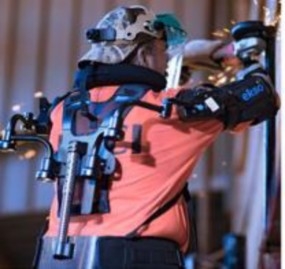
Agricultural exoskeletons can aid in the healing process without interfering with the farmer’s lifestyle. While an exoskeleton should not replace rest and rehabilitation, and should not be used against doctor’s recommendations, exoskeletons could aid recovery from an injury by providing additional support (Upasani et al. 2019). Taking time away from work is ideal for anyone recovering from an injury, but an exoskeleton may provide protection and autonomy to those whose livelihood prevents them from staying idle for long.
Aging Workforce
For many, agriculture is more than a profession. It is a culture, a family legacy, and a way of life. As such, many feel tied to the industry well past retirement age. The 2017 agricultural census of the United States showed that 60% of Virginia’s farmers are over 55 years old (National Agricultural Statistics Service 2019). Farmers between 45-65 years old were also identified as within the age range most likely to sustain a work-related injury (Johnson et al. 2021). As such, health conditions associated with aging, like slower recovery times from exertion or injury, arthritis, chronic pain, and loss of balance, coordination, strength, and flexibility are becoming more of a concern in the agricultural workforce, and put farmers at risk for secondary or overuse injuries (Grisso 2020).
Agricultural exoskeletons can provide an extra level of stability and support for farmers who need it. While not intended for permanent reliance, agricultural exoskeletons can be worn on the hand when arthritis is flaring up, or worn to provide stability and to enhance strength and balance when moving cattle. Periods in a farmer’s workday when the risk of injury is increased (due to fatigue or the nature of the work) can be made safer through the development and use of agriculture specific exoskeletons. For examples, see ALCE-303 “What’s an Agricultural Exoskeleton?”.
Type of Activities
Farmers, ranchers, and farmworkers often find themselves in physically awkward and physically demanding positions while carrying out their work. Whether that be loading bales of hay into a loft, repairing fence lines, or sitting in a vibrating tractor for several hours while harvesting, the type of activities a farmer must do are varied and demanding.
Maintaining a prolonged postures, like stooping and bending can put additional strain on the lower back and contribute to the injuries previously described (Toxiri et al. 2019; Upasani et al. 2019). When those positions are coupled with twisting or lifting the chance of injury is increased. While some of those positions can be adjusted to be more ergonomic, others like pulling a calf during calving cannot be adjusted adapted as easily. An exoskeleton can help the farmer return to a steady position, provide additional strength when moving loads, and reduce the fatigue of maintaining an awkward or uncomfortable position (Upasani et al. 2019).
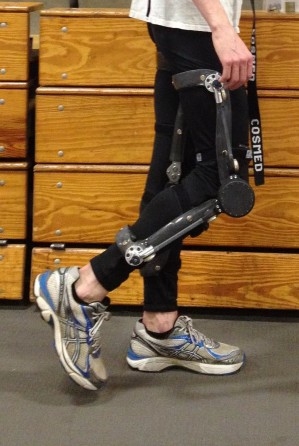
Livestock
Working with livestock is one of the most hazardous activities a farmer can take part in (Johnson et al. 2021). Livestock can be startled by a passing truck, territorial of their paddock, and protective of young (Kyle et al. 2021). Furthermore, horses and mules have blind spots in their vision which increases the chance of injury. Even an experienced livestock handler may find themselves in hazardous situations because livestock respond to sounds and movement out of the control of the farm worker.
These hazards and risks may be compounded by arthritis, lack of balance, or primary injury. In an industry that often requires agricultural workers to continue working in hazardous situations, an exoskeleton can provide additional strength to counter the effects of joint or neuromuscular diseases allow farmworkers to complete their task more safely and easily (Sarac, Solazzi, and Frisoli 2019).
Work Conditions
As mentioned previously, the current stock of exoskeletons has been developed primarily for military, commercial, or rehabilitative uses (Sarac, Solazzi, and Frisoli 2019). Agriculture is quite different from those fields. While there may be some overlap with agriculture, those exoskeletons were not designed to work in the unique conditions of the agricultural industry.
Atypical Workday
Current uses for exoskeletons can rely on a consistent or predictable work schedule. As we noted previously, work on a farm is neither consistent nor predictable. Agriculture is not a 9 to 5 job. Farmers, ranchers, farmworkers are sometimes required to work long hours to finish harvesting or tend to livestock among other situations. Additionally, work on the farm involves a variety of tasks that farmworkers must shift between. Shifting between tasks can result in engaging different muscle groups at irregular intervals and pose changing environmental hazards.
Current exoskeleton technologies are designed to operate within a designated work environment and to perform a predictable set of tasks. This design specificity makes exoskeletons great for some applications, but potentially hazardous for others (Toxiri et al. 2019). Designing an agriculture- specific exoskeleton will require farmer input on what strains they endure, their work schedule day-to- day, and their ability to adapt to changing conditions.
Varying Sanitation
Working on a farm includes confronting issues of sanitation and biosecurity, like dealing with manure or plant diseases. As farmers know, maintaining and cleaning equipment is important not only to ensure that the piece of equipment works properly, but also to maintain the health of the farmer. Farmers must consider exoskeletons as another piece of farm equipment. Taking care of exoskeletons when they are used in dirty conditions will be as important as for any other piece of equipment. An agricultural exoskeleton will have to travel with a farmer anywhere they might need it. Consulting farmers, ranchers, and farmworkers as to what conditions the exoskeletons are exposed to will be important for the exoskeleton’s longevity.
Conversely, exposing animals to diseases is another major concern. In chicken facilities, for example, employees are often required to wear sanitation suits to avoid spreading harmful pathogens to the flock. In agricultural facilities where a high degree of sanitization and biosecurity is required, an agricultural exoskeleton will need to be able to accommodate those extra precautions. A farmer’s perspective is needed to better understand the extent to which an exoskeleton will need to be covered and/or sanitized for the work environment.
Inclement Weather
Unlike some work environments where the employees are indoors, or where work can be delayed in case of inclement weather, farming must continue despite the weather. Regardless of how deep the snow is or how hard the wind is blowing, animals still need to be taken care of and crops still need to be tended to. The severity and type of weather each farmer experiences depends on the climactic conditions of their location.
This means agricultural exoskeletons must be designed to withstand and function in rain, heat, cold, and wind among other weather conditions. An exoskeleton used in agricultural settings must maintain a dependable operating ability in adverse weather. Additionally, being comfortable during different weather events will be important to farmers as well. Unlike other working conditions where the climate can be relatively controlled or understood, farmers will need to be at the design table to make their weatherproofing needs heard.
Large Machines
Agriculture is always trying to do more with less. One way the industry has been able to do so is by scaling up their tractors, sprayers, irrigation systems, and the like to reach larger swaths of land in less time. Working with large machinery provides two opportunities for agricultural exoskeletons to play a role: increasing accessibility after an injury and injury prevention.
The reliance on large machinery increases the risk of injury associated with tractor roll-overs or getting tangled in power take-off (PTO) shafts (Kyle et al. 2021; Murphy 2022). Often, injuries of this kind are severe and can require rehabilitation afterwards. As mentioned previously, while the best solution is to take time off and recover, the nature of agriculture does not always allow this. Running a farm business can have the effect of incentivizing farmers to cut recovery short, increasing the risk of secondary injury because lost time often equates to lost income (Grisso 2020). An exoskeleton, while not solving the root of this issue, could make it easier for farmers to return to work sooner or work more comfortably after sustaining an injury.
Even without injury, large machinery can pose a barrier to some. Large tractors and combines require farmers, ranchers, and farmworkers to climb up into the machinery (Ehlers and Field 2019). While other solutions like chair lifts are available, those solutions are not ideal for all farms and all abilities. Those with limited mobility, strength, or balance due to age or other circumstances may prefer to use an exoskeleton to help steady themselves or propel them during the climb with an exoskeleton.
Exoskeletons have the potential to be a great tool for farmers but are not a catch-all or appropriate in every situation. Considerations need to be given to how wearing an exoskeleton changes the way farmers interact with their equipment. Does a tractor have a rollover protection system (ROPS)? Does the farmer wear a seatbelt if their tractor is equipped with ROPS? (Wearing a seatbelt in a tractor without ROPS is not recommended). How loose fitting is a farmer’s clothing? (For example, how likely is it that the farmer’s clothing may be pulled into a PTO?).Does the exoskeleton have exposed wires that a PTO can catch? Does the battery pack prevent the seatbelt from latching properly? An agricultural exoskeleton will need to consider all factors contributing to risk to ensure the exoskeleton does not inadvertently increase the risk of harm.
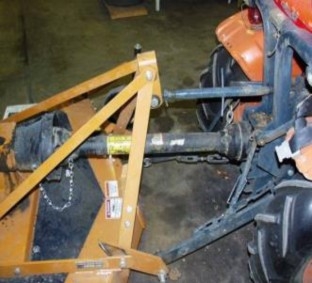
Conclusion
An agricultural specific exoskeleton can fill the gap in market demand and functionality. Agricultural workers face unique workplace hazards and requirements that can benefit from the rehabilitation and injury prevention ability of exoskeletons. While current exoskeletons can overlap with agriculture, most exoskeletons are not designed to operate in the demanding environment of the farm or ranch. The workplace environments and requirements can be so different and varied, an agriculture exoskeleton will need direct input from farmers, ranchers, and farmworkers to adequately understand what capabilities are required from an agricultural exoskeleton.
References
Alemi, Mohammad Mehdi, Jack Geissinger, Athulya A. Simon, S. Emily Chang, and Alan T. Asbeck. 2019. “A Passive Exoskeleton Reduces Peak and Mean EMG during Symmetric and Asymmetric Lifting.” Journal of Electromyography and Kinesiology 47 (August): 25–34. https://doi.org/10.1016/j.jelekin.2019.05.003.
Ehlers, Shawn G., and William E. Field. 2019. “Accessing and Operating Agricultural Machinery: Advancements in Assistive Technology for Users with Impaired Mobility.” Assistive Technology 31 (5): 251–58. https://doi.org/10.1080/10400435.2018.1435 591.
Grisso, Robert. 2020. “Preventing Secondary Injuries in Agricultural Workplaces.” Virginia Cooperative Extension 442 (085).
Grisso, Robert, John Perumpral, Kristen Pevarski, and Kirk Ballin. 2010. “Assistive Technologies in Agriculture.” Virginia Cooperative Extension 442 (084).
Johnson, Anthony, Lorena Baccaglini, Gleb R Haynatzki, Chandran Achutan, Dana Loomis, and Risto H Rautiainen. 2021. “Agricultural Injuries among Farmers and Ranchers in the Central United States during 2011-2015.” Journal of Agromedicine 26 (1): 62–72. https://doi.org/10.1080/1059924X.2020.184 5268.
Kyle, Crystal, Kim Niewolny, Nicole Orndoff, Don Ohanehi, Kirk Ballin, Joe Young, Steve Bridge, Tristan Robertson, and Garland Mason. 2021. “The Basics of On-Farm Safety: An Introductory Guide by the AgrAbility.” Virginia Cooperative Extension 151 (NP).
Murphy, Dennis. 2022. “Power Take-Off (PTO) Safety.” Penn State Extension, 4.
National Agricultural Statistics Service. 2019. “2017 Census of Agriculture.” State and County Data AC-17-A-46. Geographic Area Series. Washington, D.C.: USDA.
Olar, Marius-Leonard, Monica Leba, and Marius Risteiu. 2021. “Exoskeleton - Wearable Devices. Literature Review.” Edited by M. Lazar, F. Faur, and M. Popescu-Stelea. MATEC Web of Conferences 342: 05005. https://doi.org/10.1051/matecconf/20213420 5005.
Sarac, Mine, Massimiliano Solazzi, and Antonio Frisoli. 2019. “Design Requirements of Generic Hand Exoskeletons and Survey of Hand Exoskeletons for Rehabilitation,Assistive, or Haptic Use.” IEEE Transactions on Haptics 12 (4): 400–413. https://doi.org/10.1109/TOH.2019.2924881.
Toxiri, Stefano, Matthias B. Näf, Maria Lazzaroni, Jorge Fernández, Matteo Sposito, Tommaso Poliero, Luigi Monica, Sara Anastasi, Darwin G. Caldwell, and Jesús Ortiz. 2019. “Back-Support Exoskeletons for Occupational Use: An Overview of Technological Advances and Trends.” IISE Transactions on Occupational Ergonomics and Human Factors 7 (3–4): 237–49. https://doi.org/10.1080/24725838.2019.1626 303.
Upasani, Satyajit, Roberto Franco, Kim Niewolny, and Divya Srinivasan. 2019. “The Potential for Exoskeletons to Improve Health and Safety in Agriculture—Perspectives from Service Providers.” IISE Transactions on Occupational Ergonomics and Human Factors 7 (3–4): 222–29. https://doi.org/10.1080/24725838.2019.1575 930.
Wevolver. 2022. “Clutch Spring Knee Exoskeleton.” Clutch Spring Knee Exoskeleton. 2022. https://www.wevolver.com/specs/clutch.spring.knee.exoskeleton.
Additional Resources
If you are curious about how arthritis can impact your agricultural work and ways to manage it, please consider the following resource.
Grisso, Robert, and S. Christian Mariger. 2020. “Arthritis and Farming.” Virginia Cooperative Extension, 442, 083. http://hdl.handle.net/10919/98296
If you are interested in how agricultural exoskeletons can help farmers stay safe and healthy on the farm, please consider the following resource.
Smilnak, D., Mason, G., Franco, R., Niewolny, K., & Leonessa, A. (2023). What is an Agricultural Exoskeleton? Virginia Cooperative Extension. https://www.pubs.ext.vt.edu/ALCE/alce-303/alce-303.html
The following resources provide insights on the current exoskeleton offerings. While not an endorsement of any particular product, the following links can provide examples of how to use an exoskeleton and provide a cost estimate.
Cyberdyne. 2022. “HAL for Medical Use (Lower Limb Type).” 2022. https://cyberdyne.jp/english/products/LowerLimb_medical.html.
EksoBionics. 2021. “EksoWorks.” Ekso Bionics. January 14, 2021. https://eksobionics.com/eksoworks/
Sarcos Robotics. 2022. “Guardian XO Overview.” Sarcos Robotics. 2022. https://www.sarcos.com/products/guardian-xo-powered-exoskeleton/
SuitX. 2022. “What Are Industrial/Occupational Exoskeletons.” An Introduction. 2022. https://www.suitx.com/
Watson, Bree. 2019. “Onyx Exoskeleton: An Inside Look at Lockheed Martin’s Wearable Robot.” Pegasus Magazine. 2019. https://www.ucf.edu/pegasus/power-move-onyx-exoskeleton/
Acknowledgements
AgrAbility Virginia is funded by AgrAbility Project, USDA/NIFA Special Project 2019-2022 (41590-22326).
Virginia Cooperative Extension materials are available for public use, reprint, or citation without further permission, provided the use includes credit to the author and to Virginia Cooperative Extension, Virginia Tech, and Virginia State University.
Virginia Cooperative Extension is a partnership of Virginia Tech, Virginia State University, the U.S. Department of Agriculture (USDA), and local governments, and is an equal opportunity employer. For the full non-discrimination statement, please visit ext.vt.edu/accessibility.
Publication Date
February 15, 2023



